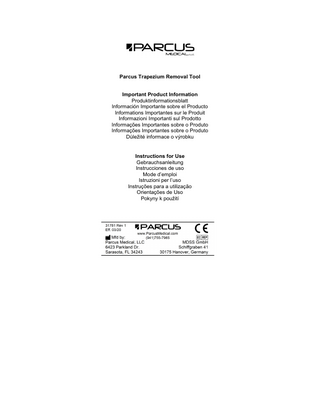9 Pages

Preview
Page 1
Parcus Trapezium Removal Tool (English) 1. Indications: The Parcus Trapezium Removal Tool is designed to aid in removal of the trapezium bone. 2. Warnings: A. Caution: Federal Law restricts this device to sale by or on the order of a physician. B. Do not use this product if it is bent or there is visible damage to the shaft or drive section. C. This device is not intended to be used as an implant. 3. Material: This device is manufactured from a Stainless Steel Alloy and may include an aluminum alloy handle. The materials used in the manufacture of this device are radio-opaque and can, therefore, be detected with conventional X-Ray or fluoroscopy. 4. Inspection: A. Inspect the device for damage at all stages of handling. B. If damage is detected, consult the manufacturer for guidance. 5. Cleaning: A. Immediate rinsing and cleaning after use with an enzymatic detergent will effectively remove and prevent drying of adherent blood, tissue, etc. B. Scrub device with a soft brush, paying special attention to areas where debris might accumulate. Always avoid any harsh materials that can scratch or mar the surface of the device. C. Rinse the device thoroughly with water following the cleaning process. 6. Sterilization: A. This device is not provided sterile. It should be cleaned and sterilized using validated protocols before each use. B. The following table provides recommended minimum sterilization parameters that have been validated by Parcus Medical to provide a 10-6 sterility assurance level (SAL): Cycle Type
Minimum Temperature
Minimum Exposure Time (Wrapped)
Minimum Dry Time
Pre-Vacuum
132°C / 270°F
4 Minutes
30 Minutes
1
1 Drying times vary according to load size and should be increased for larger loads.
7. Instructions for use: A. Place the tip of the Trapezium Removal Tool on the surface of the bone. Dense bone may require that a pilot hole be created to more easily engage the threads in the bone. B. Thread the Trapezium Removal Tool into the trapezium so that all of its threads are fully inserted and flush with the surrounding bone. C. Use the Trapezium Removal Tool as a lever to create space to use suitable instruments to free the trapezium from its attachments to the surrounding bones. D. When free from the surrounding bone, avulse and remove the trapezium.